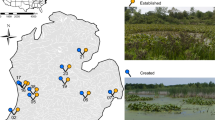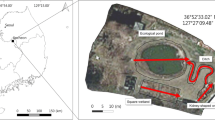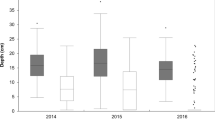Abstract
Five three- to four-year old created palustrine/emergent wetland sites were compared with five nearby natural wetlands of comparable size and type. Hydrologic, soil and vegetation data were compiled over a nearly two-year period (1988-90). Created sites, which were located along major highways, exhibited more open water, greater water depth, and greater fluctuation in water depth than natural wetlands. Typical wetland soils exhibiting mottling and organic accumulation were wanting in created sites as compared with natural sites. Typha latifolia (common cattail) was the characteristic emergent vegetation at created sites, whereas a more diverse mosaic of emergent wetland species was often associated with Typha at the natural sites. Species richness was slightly higher in created (22–45) vs. natural (20–39) wetlands, but the mean difference (33 vs. 30) was not significant. Nearly half (44%) of the 54 wetland taxa found at the various study sites were more frequently recorded at created than natural wetlands. The presence of mycorrhizae in roots of Typha angustifolia (narrow-leaved cattail) and Phragmites australis (common reed) was greater at created than natural wetlands, which may be related to differential nutrient availability. Wildlife use at all sites ranged from occasional to rare, with more sightings of different species in the natural (39) than created (29) wetlands. The presence of P. australis and introduced Lythrum salicaria (purple loosestrife) may pose a threat to future species richness at the created sites. One created site has permanent flow-through hydrology, and its vegetation and wildlife somewhat mimic a natural wetland; however, the presence of P. australis and its potential spread pose an uncertain future for this site. This study suggests the possibility of creating small palustrine/emergent wetlands having certain functions associated with natural wetlands, such as flood water storage, sediment accretion and wildlife habitat. It is premature to evaluate fully the outcome of these wetland creation efforts. A decade or more is needed, emphasizing the importance of long term monitoring and the need to establish demonstration areas.
Similar content being viewed by others
References
Adamus, P.R., Clairain, E.J., Smith, R.D. and Young, R.E. 1987. Wetland Evaluation Technique (WET): Vol. II: Methodology. Operational Draft TRY-87, U.S. Army Engineer Waterways Experiment Station, Mississippi, USA.
Anderson, R.C., Liberta, A.E. and Dickman, L.A. 1984. Interaction of vascular plants and vesicular-arbuscular mycorrhizal fungi across a soil moisture nutrient gradient. Oecologia 64: 111–117.
Bonasera, J., Lynch, J. and Leck, M.A. 1979. Comparison of the allelopathic potential of four marsh species. Bulletin of the Torrey Botanical Club 106: 217–222.
Brauning, D.W. 1989. Wetland songbirds. In: Wetlands Ecology and Conservation: Emphasis in Pennsylvania. pp. 205–215. Edited by S.K. Majumbar, R.P. Brooks, F.J. Brenner and R.W. Tiner Jr. The Pennsylvania Academy of Science.
Brown, M. and Dinsmore, J.I. 1986. Implications of marsh size and isolation for marsh bird management. J. of Wildlife Management 50: 392–397.
Butts, M.P. 1986. Status of wetlands creation/mitigation projects on state highway projects in Connecticut. In: Proc. of the National Wetland Symposium: Mitigation of Impacts and Losses. New Orleans, Louisiana, Oct. 8–10, 1986. pp. 185–187. Edited by J.A. Kusler, M.L. Quammen, and G. Brooks. Assoc. of State Wetland Managers, Berne, New York, USA.
Clewell, A.F. 1981. Vegetational restoration techniques on reclaimed phosphate strip mines in Florida. Wetlands 1: 158–170.
Confer, S.R. 1990. Comparison of Created and Natural Freshwater Palustrine-Emergent Wetlands in Connecticut. Masters thesis, Connecticut College, New London, Connecticut, USA.
Connell, J. and Slatyer, R.O. 1977. Mechanisms of succession in natural communities and their role in community stability and organization. American Naturalist 111: 1119–1144.
Cooke, J.C. and Lefor, M.W. 1990. Comparison of vesicular-arbuscular mycorrhizae in plants from disturbed and adjacent undisturbed regions of a coastal salt marsh in Clinton, Connecticut, U.S.A. Environmental Management 14: 131–137.
Cowardin, L.M., Carter, V., Golet, F.C. and LaRoe, E.T. 1979. Classification of wetlands and deepwater habitats of the United States. U.S. Fish and Wildlife Service. Biological Services Program; FES/OBS-79–31. Washington, D.C.
Crawford, R.D. 1986. Evaluation of Constructed Bonds as a Means of Replacing Natural Wetland Habitat Affected by Highway Projects in North Dakota-Phase II. Final report no. 462290, North Dakota Univ. Dept. Biol. & FHWA Rept. no. FWA-ND-RD(2)-81A, FCP 43E2-462.
D'Avanzo, C. 1986. Vegetation in freshwater replacement wetlands in the Northeast. In: Mitigating Freshwater Alterations in the Glaciated Northeastern United States: An Assessment of the Science Base. pp. 53–81. Edited by J.S. Larson and C. Neill. Proc. of a Workshop. Univ. of Massachusetts, Amherst. Univ. of Massachusetts, Amherst, Massachusetts, USA. Pub. no. 87–1.
Donahue, R.L., Miller, R.W. and Schickluna, J.C. 1977. Soils: An Introduction to Soils and Plant Growth. Prentice Hall, Inc., Englewood Cliffs, New Jersey, USA.
Egler, F.E. 1954. Vegetation science concept. I. Initial floristic composition: a factor in old-field vegetation development. Vegetatio 4: 412–417.
Erwin, K.L. and Best, G.R. 1985. Marsh community development in a central Florida USA phosphate surface-mined reclaimed wetland. Wetlands 5: 155–160.
Golet, F.C. and Larson, J.S. 1974. Classification of Freshwater Wetlands in the Glaciated Northeast. Resource Pub. no. 116, Bureau of Sport Fisheries and Wildlife, Washington, D.C.
Grace, J.B. 1983. Autotoxic inhibition of seed germination by Typha latifolia: an evaluation. Oecologia 59: 366–369.
Grace, J.B. 1987. The impact of preemption on the zonation of two Typha species along lakeshores. Ecological Monographs 57: 283–303.
Grace, J.B. 1989. Effects of water depth on Typha latifolia and Typha domingensis. American Journal Botany. 76: 762–768.
Hardin, D.L. 1975. Animal Community Structure of Adirondack Wetlands. Dissertation, State Univ. of New York, College of Environmental Science and Forestry, Syracuse, New York, USA.
Hollands, G.C., Hollis, G.E. and Larson, J.S. 1986. Science base for freshwater wetland mitigation in the glaciated northeastern United States: hydrology. In: Mitigating Freshwater Alterations in the Glaciated Northeastern United States: An Assessment of the Science Base. pp. 131–143. Edited by J.S. Larson and C. Neill. Proc. of a Workshop. Univ. of Massachusetts, Amherst. Sept. 29–30, 1986. Pub. no. 87–1.
Isabelle, P.S., Fooks, L.J., Keddy, P.S. and Wilson, S.D. 1978. Effects of roadside snowmelt on wetland vegetation: an experimental study. J. of Environmental Management 25: 57–60.
Kusler, J.A. and Kentula, M.E. 1989. Wetland Creation and Restoration: The Status of the Science, Vol. 1. EPA 600/3–89/038, Environmental Research Laboratory, Corvallis, Oregon, USA.
Larson, J.S. 1987a. Wetland mitigation in the glaciated Northeast: risks and uncertainties. In: Mitigating Freshwater Alterations in the Glaciated Northeastern United States: An Assessment of the Science Base. pp. 4–16. Edited by J.S. Larson and C. Neill. Proc. of a Workshop. Univ. of Massachusetts, Amherst, Sept. 29–30, 1986. Pub. no. 87–1.
Larson, J.S. 1987b. Wetlands and flooding: assessing hydrologic functions. In: Proceedings of the National Wetland Symposium: Wetland Hydrology. pp. 278–282. Edited by J.A. Kusler and G. Brooks. Assoc. of State Wetland Managers, Berne, New York, USA.
Larson, J.S. 1988. Wetland creation and restoration. In: Increasing Our Wetland Resources. pp. 73–79. Edited by J. Zelasny and J.S. Feierabent. Proc. Conference National Wildlife Council, Oct. 4–7, 1987. National Wildlife Federation, Washington, D.C.
Lomolino, M.V. 1982. Species-area and species-distance relationships of terrestrial mammals in the Thousand Islands region. Oecologia 54: 72–75.
Lowry, D.J. 1989. Restoration and creation of palustrine wetlands associated with riverine systems of the glaciated Northeast. In: Wetland Creation and Restoration: The Status of the Science, Vol. 1. pp. 173–186. Edited by J.A. Kusler and M.E. Kentula. EPA 600/3–89/038a, Environmental Research Laboratory, Corvallis, Oregon, USA.
Maltby, E. 1987. Soils science base for freshwater wetland mitigation in the northeastern United States. In: Mitigating Freshwater Alteration in the Glaciated Northeastern United States: An Assessment of the Science Base. pp. 17–52. Edited by J.S. Larson and C. Neill. Proc. of a Workshop. Univ. of Massachusetts, Amherst, Sept. 29–30, 1986. Univ. of Massachusetts, Amherst, Massachusetts, USA. Pub. no. 87–1.
Marble, A. 1976. The Wetlands of New Canaan: An Ecological Inventory and Analysis. Dept. of Landscape Architecture and Regional Planning, Univ. of Pennsylvania, Philadelphia, Pennsylvania, USA.
Marks, P.L. 1983. On the origin of the field plants of the northeastern United States. American Midland Naturalist 122: 210–228.
McNaughton, S.J. 1968. Autotoxic feedback in relation to germination and seedling growth in Typha latifolia. Ecology 49: 367–369.
McVoy, G.R. 1986. Advantages of open water/emergent wetlands for mitigation and a holistic approach to banking. In: Proc. of the National Wetland Symposium: Mitigation of Impacts and Losses. New Orleans, Louisiana, Oct. 8–10, 1986. pp. 289–290. Edited by J.A. Kusler, M.L. Quammen, and G. Brooks Assoc. of State Wetland Managers, Berne, New York, USA.
Mitsch, W.J. and Gosselink, J.G. 1986. Wetlands. Van Nostrand Reinhold Co., New York.
Nichols, G.E. 1915. The vegetation of Connecticut IV. Plant societies in lowlands. Bulletin of the Torrey Botanical Club 42: 69–217.
Niering, W.A. 1985. Wetlands. The Audubon Society Nature Guides. Chanticleer Press, Inc., New York.
Niering, W.A. 1986. Wetlands hydrology and vegetation dynamics. In: Proc. of the National Wetland Symposium: Mitigation of Impacts and Losses. New Orleans, Louisiana, Oct. 8–10, 1986. pp. 320–322. Edited by J.A. Kusler, M.L. Quammen, and G. Brooks. Assoc. of State Wetland Managers, Berne, New York, USA.
Niering, W.A. 1989. Wetland vegetation development. In: Wetlands Ecology and Conservation: Emphasis in Pennsylvania. pp. 103–113. Edited by S. Majumbar, R.P. Brooks, F.J. Brenner and R.W. Tiner, Jr. The Pennsylvania Academy of Science.
Novitzki, R.P. 1989. Wetland hydrology. In: Wetlands Ecology and Conservation: Emphasis in Pennsylvania. pp. 47–64. Edited by S.K. Majumbar, R.P. Brooks, F.J. Brenner and R.W. Tiner Jr. The Pennsylvania Academy of Science.
Odum, E.P. 1969. The strategy of ecosystem development. Science 164:262–270.
Pierce, G.J. 1989. Wetland soils. In: Mitigating Freshwater Alterations in the Glaciated Northeastern United States: An Assessment of the Science Base. pp. 65–74. Edited by J.S. Larson and C. Neill. Proc. of a Workshop. Univ. of Massachusetts, Amherst, Sept. 29–30, 1986. Univ. of Massachusetts, Amherst, Massachusetts, USA. Pub. no. 87–1.
Rafe, R.W., Usher, M.B. and Jefferson, R.G. 1985. Birds on reserves: the influence of area and habitat on species richness. Journal of Applied Ecology 22: 327–336.
Reed, P.B., Jr. 1988. National List of Plant Species That Occur in Wetlands: Northeast (Region 1) U.S. Dept. of Interior, Fish & Wildlife Service. Biological Report 88 (26.1).
Reimold, R. and Cobler, S. 1986. Wetland mitigation effectiveness. Metcalf & Eddy, Inc. Wakefield, Massachusetts, USA.
Rossiter, J.A. and Crawford, R.D. 1981. Evaluation of Constructed Ponds for Replacement of Wetlands Affected by Highway Projects, Univ. of North Dakota, Dept. of Biology and Federal Highway Administration, Rept. no. FHWA-ND-81-80.
Shisler, J.K. 1989. Creation and restoration of coastal wetlands of the northeastern United States. In: Wetland Creation and Restoration: The Status of the Science. Vol. 1. pp. 145–165. Edited by J.A. Kusler and M.E. Kentula. EPA 600/3–89/038a, Environmental Research Laboratory, Corvallis, Oregon, USA.
Smith, J.G. and Klemmedson, J.O. 1964. Cheatgrass, Bromus tectorum. Botanical Review 30: 226–262.
Tanner, C.C. and Clayton, J.S. 1985. Vesicular-arbuscular mycorrhizae studies with a submerged aquatic plant. Transactions of the British Mycological Society 85: 683–688.
Tiner, R.W., Jr. 1984. Wetlands in the United States: Current Status and Recent Trends. U.S. Fish and Wildlife Service, National Wetland Inventory Project, Washington, D.C.
USDA, Soil Conservation Service. 1975. Soil Taxonomy. Agricultural Handbook no. 436. U.S. Govt. Printing Office, Washington, D.C.
van der Valk, A.G. 1981. Succession in wetlands: a Gleasonian approach. Ecology 62: 688–696.
van der Valk, A.G. 1982. Succession in temperate North American wetlands. In: Wetlands: Ecology and Management. pp. 169–179. Edited by B. Gopal, R.E. Turner, R.G. Wetzel and D.F. Whigham. National Institute of Ecology and International Scientific Publications. Jaipur, India.
van der Valk, A.G. and Davis, C.B. 1979. The role of seedbanks in the vegetation dynamics of prairie glacial marshes. Ecology 59: 322–335.
Weller, M.W. and Fredrickson, L.H. 1973. Avian ecology on a managed glacial marsh. The Living Bird 12: 269–291.
Weller, M.W. 1975. Studies of cattail in relation to management for marsh wildlife. Iowa State Journal of Research 49: 383–412.
Zedler, J.B. and Kentula, M.E. 1986. Wetland Research Plant. EPA/600/3–86/009, Environmental Research Lab. Corvallis, Oregon, USA.
Author information
Authors and Affiliations
Rights and permissions
About this article
Cite this article
Confer, S.R., Niering, W.A. Comparison of created and natural freshwater emergent wetlands in Connecticut (USA). Wetlands Ecol Manage 2, 143–156 (1992). https://doi.org/10.1007/BF00215321
Issue Date:
DOI: https://doi.org/10.1007/BF00215321




